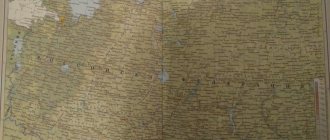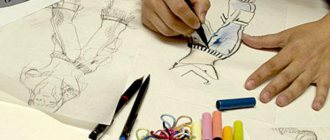Open technology lesson in 5th grade on the topic: “Making simple hand stitches”
Open technology lesson in 5th grade
on the topic: “Performing simple hand stitches”
technology teacher
Municipal educational institution Dmitrovskaya secondary school No. 9
Section topic:
« Handicrafts. Technology for performing simple hand stitches"
Lesson topic:
"Performing simple hand stitches"
The purpose of the lesson:
to familiarize students with the types of hand stitches and develop skills in their implementation, observing technological sequence and safety precautions.
Lesson objectives:
1. To develop knowledge about hand embroidery, to familiarize with the types of stitches “forward needle” and “lace”, to teach how to perform a task based on a sample, to teach independence in performing creative work;
2. Develop sensory and motor skills; the ability to plan your work, adjust and evaluate your work, applying the knowledge and skills acquired in technology lessons; creative abilities of the individual.
3. Fostering hard work, attentiveness and accuracy in work; formation of aesthetic taste, interest in the art and culture of one’s people, culture of speech, clothing and behavior.
Lesson type:
combined; explanation of new material.
Form of organization of student activities
: individual, collective, in small groups (pairs).
Teaching methods:
explanatory and illustrative, demonstration, partially search, modeling, independent work.
Health-saving technologies:
safety instructions, psychologically comfortable communication, color therapy, music therapy, change of physical activity, physical education minutes.
Equipment and materials:
technical means and software for demonstrating a presentation about the types of embroidery, its application in Russian folk and modern costume; hand embroidery samples made by students; handouts: instructional and technological cards “Embroidery Instructions”, “Making a “forward needle” and “lace” seam; task cards; pieces of cotton fabric; a set of tools and accessories for embroidery (fabric for embroidery, pattern design, needles, hoops, floss, scissors, thimble); musical accompaniment - Russian folk melodies.
During the classes
I.
Organizational part of the lesson (3 min).
The teacher welcomes students, gets to know them, checks the appearance and organization of students’ workspaces, and uses a variety of motivational techniques that ensure:
· creating a psychologically comfortable atmosphere of communication and cooperation;
· creating a situation of success in the lesson;
· organization of subject content corresponding to the capabilities of each child;
· determination of personal status in teamwork.
II.
Introductory briefing (5 min).
1.
Statement of the topic and goals of the lesson, connection of the new topic with the previous one.
2.
Repetition of the subject material covered.
Oral frontal survey. Questions for students:
— What types of hand stitches did you use when making the apron?
- Why are these sutures called protozoa?
— Where can you use the simplest hand stitches?
— What do you know about embroidery?
— What can embroidery be used for?
—Which of you knows how to embroider?
3. Motivation of students.
The teacher's story about embroidery as an ancient decorative and applied art, showing a presentation and embroidered works of students.
Embroidery in Rus' was used to decorate clothes.
What kind of clothes did they wear back then?
Was it different from ours? of ? Look at the slide: the clothes were long and wide, so that it was comfortable to work in the field.
The usual idea of a Russian women's costume is usually
associated with a shirt, sundress, belt, and sometimes an apron. In the north, sundresses were often complemented by an epanechka, and in cold weather a long-sleeved soul warmer was worn over the sundress. The most common headdress was kokoshnik hard cap decorated with freshwater gold and silver threads Look how beautiful they were, because they were richly decorated with embroidery. The combination of white and red is a distinctive feature of both embroidery and Russian folk clothing in general.
Other things were also decorated with embroidery, for example, towels, towels, pillows, bedspreads, etc.
Today, there is a return of interest in embroidery and world fashion designers demonstrate luxurious embroidered suits, shoes and accessories at fashion shows.
III.
Current briefing (3 min)
1.
Review of safety precautions when performing manual work.
Frontal safety survey.
— What requirements must a workplace for handicrafts meet?
— What safety rules do you know when working with scissors, needles, pins and irons?
— How to choose the right needle and thread it?
— How to choose the correct length of thread and cut it?
— What threads and fabrics are used in needlework? for embroidery?
— What is the name of the device for stretching fabric for embroidery?
2. To reinforce concepts,
with which we will work in the lesson, it is proposed to solve the puzzle. In two columns there are halves of words, from which you need to add terms related to the topic of the lesson.
| PAL |
| HIGHER |
| PASS |
| CAN |
| INE |
| ROCK |
| MENT |
| LA |
| NICE |
| NAYA |
| SHNU |
| MULE |
| TSY |
| ISIS |
| ORNA |
| CHECK |
| MA |
| VA |
| VKA |
| KNIFE |
Answer: hoop, embroidery, skein, canvas, floss, lace, ornament, needle, counting, scissors.
3.
Physical education minute.
Exercise for the eye muscles. Look straight ahead. Without turning your head, move your gaze to the right and maintain this position, counting to yourself to 3. Do the same, moving your eyes down, left and up. Don't forget that you can't turn your head. After resting a little, repeat the same movement in the opposite direction - left, down, right, up.
IV.
Learning new material (30 min).
Today in the lesson we will learn how to perform two hand stitches: “forward needle” and “lace”. In the next lessons we will master other types of hand stitches, with which we will embroider the “Flower” ornament. This ornament can be used to make a napkin, potholder, handkerchief, etc.
1. Instructions for embroidery
(handouts on work tables). The teacher introduces students to the instructions (students read all points aloud and the teacher explains), then demonstrates and comments, and students repeat the basic work techniques at their workplaces:
· determination of warp thread and weft thread on a fabric sample;
· choice of fabric (plain-dyed and printed);
· types of threads for needlework (natural and artificial);
· threading the fabric into the hoop;
· choice of floss thread color;
· determining the length of the thread and cutting it (double the length of the elbow, at an angle of 45 degrees);
· separating 3 threads from the floss skein (the work is done in pairs);
· threading a needle (the threading technique is shown if the “eye” of the needle is very small);
· securing the working thread to the fabric at the beginning of the seam.
2.Explanation of new material
. A needle-forward stitch is a series of stitches of the same size, made at intervals. This is the simplest stitch used in embroidery. The thread is secured at the right edge of the fabric, making a stitch of 5 mm. Then the needle is inserted into the point of the second puncture and pulled along with the loop to the wrong side. Skipping the same distance, the needle is brought to the front side, a second stitch is made, etc. The stitches are placed in the direction from right to left. On the wrong side of the fabric, stitches of the same length are placed between the knit stitches. We will embroider with a “forward needle” seam along a drawn outline in one row, using threads of different colors; you can find many interesting designs for this seam (show on the slide an instructional and technological map for making a “forward needle” seam).
Get full text
3. Practical work No. 1.
Students approach the teacher, who demonstrates how to make a “forward needle” seam on the fabric, then at their work stations they independently perform this seam according to the “Flower” ornament drawn on the fabric. When making an ornament, it is important to remember the color scheme and select threads that match the color.
4. Physical education minute. Hand exercises:
clench your fingers into a fist and forcefully, straining each finger, spread them out - repeat 10 times, using the counting rhyme: “We embroidered, we embroidered - our fingers are tired. Now we’ll rest a little and start embroidering again.”
Explanation of new material
. The “lace” seam is performed in two steps. First, along the contour of the pattern, seam stitches are made “forward with the needle”, then a needle and thread (can be of a different color) are brought under each stitch from top to bottom, without piercing the fabric. If you place a needle and thread under the stitches alternately from top to bottom and from bottom to top, you will get another type of “lace” seam.
5. Practical work No. 2.
Students come up to the teacher, who shows how to make a “lace” seam on the fabric, then at their workplaces they independently perform this seam according to the “Flower” ornament drawn on the fabric.
For clarity, instructional and technological maps are placed on students’ desks. The teacher approaches each student, praises, approves, helps and checks:
· has everyone started work and is following safety rules;
· correct organization of the workplace and implementation of work methods;
· tension of the fabric on the hoop;
· securing the working thread at the beginning and end of the seam;
· self-monitoring of the quality of the operation;
· speed and quality of work.
To control the correct execution of hand stitches, the teacher asks the students to take turns making several stitches on a control sample of the ornament (involvement in creative teamwork occurs).
During independent practical work, a Russian folk song is played. In Rus', embroiderers and needlewomen always sang melodiously while working.
After completing the specified amount of work, it is necessary to remove the fabric with the ornament and iron it.
V.
Lesson summary (3-5 min).
1. General conclusions on the topic of the lesson
(students do). The teacher adds that all students completed their work efficiently, followed safety rules and organized their workplace correctly.
2. Analysis of mistakes made
.
3. Demonstration of the best works.
We award the girls who did the best handwork today with the “Young Embroiderer” medal (with an “excellent” rating in the magazine and diary).
4. Demonstration of teamwork
(separate stitches using hand stitches “forward needle” and “lace” created an ornament in the form of the number “5”). Well done everyone!
5. Homework:
those who have not completed the ornament with hand stitches should finish it at home for the next lesson, and those who have completed the work completely will make another circle of the ornament on the sample using this embroidery technique.
6. Cleaning the workplace.
Place tools and equipment in work boxes and collect thread trimmings.
7.
Thank you everyone!
Goodbye! Self-analysis of a technology lesson
in 5th grade
on the topic: “Performing simple hand stitches”
technology teachers
03/15/2011
Lesson topic:
"Performing simple hand stitches."
Chapter
« Handicrafts. Technology for making the simplest hand seams”, in previous lessons the work on making the finished product “Apron” using some types of the simplest hand seams was completed.
The purpose of the lesson:
to familiarize students with the types of simple hand stitches and develop skills in their implementation, observing technological sequence and safety precautions.
Lesson objectives:
1. To develop knowledge about hand embroidery, to familiarize with the types of stitches “forward needle” and “lace”, to teach how to perform a task based on a sample, to teach independence in performing creative work;
2. Develop sensory and motor skills; the ability to plan your work, adjust and evaluate your work, applying the knowledge and skills acquired in technology lessons; creative abilities of the individual.
3. Fostering hard work, attentiveness and accuracy in work; formation of aesthetic taste, interest in the art and culture of one’s people, culture of speech, clothing and behavior.
Lesson type:
combined; explanation of new material.
Form of organization of student activities
: individual, collective, in small groups (pairs).
Teaching methods:
explanatory and illustrative, demonstration, partially search, modeling, independent work.
Health-saving technologies:
safety instructions, psychologically comfortable communication, color therapy, music therapy, change of physical activity, physical education minutes.
The lesson was held in a specially equipped sewing workshop.
By type, the lesson is a combined lesson with its inherent stages:
— Organizational moment
— Updating the acquired knowledge
— Repetition of the material covered (checking homework)
— Studying new material (theoretical part)
— Studying new material (practical part)
— Consolidation of new material
- Homework
— Lesson summary, reflection
I believe that the combined type of lesson corresponds to this topic. In accordance with modern requirements for conducting technology lessons, 30% of the time is allocated to theory and 70% to practical work.
Everything was prepared for the lesson - lesson plan, presentation, necessary tools, devices and materials, instructional and technological cards, task cards. Pupils have properly organized workplaces.
The organizational part of the lesson was carried out clearly, the transition to the next stage was logical. The updating of previously acquired knowledge was aimed at showing their necessity today in the lesson, as well as psychologically preparing students for the topic being studied. This gave me the opportunity to assess the degree of readiness of students to perceive new material.
The students were told the topic and purpose of the lesson. To organize attention, a presentation with a slide show, instructional and technological cards, and finished embroidered products were used.
An explanation of a new topic is carried out with a demonstration of visuals (embroidered items made by students and a prepared presentation), as well as with a practical demonstration of work techniques for performing simple hand stitches. In the practical part of the lesson, students worked independently on making an ornament using the technique of simple hand stitches “forward needle” and “lace”; in the final part of the lesson, the lesson was summed up and a new topic was consolidated.
The formation of new knowledge of students was carried out by the method of story and conversation, and the acquisition of new skills through independent practical activities with the consulting assistance of a teacher. The material was presented sequentially. During the explanation, a demonstration of actions was carried out. A friendly tone was maintained throughout the lesson. The pace of work is optimal. The educational material is selected effectively in accordance with the goals and objectives of the lesson and according to the age characteristics of the children.
Questions and assignments contributed to a deeper understanding of the material. Students are taught to work independently, exercising self-control.
Introductory briefing was conducted in a form accessible to students.
Current briefing. All students are involved in practical work, monitor compliance with safety rules, and the workplace is organized.
Practical work was carried out under the supervision of the teacher; comments on incorrect execution of the simplest hand stitches “forward needle” and “lace” and violation of safety rules were made in a timely manner.
The consolidation of knowledge was carried out during the survey, which showed that the students had good assimilation of the studied material.
Workplaces were cleaned by all students and staff on duty (classroom cleaning).
At the conclusion of the lesson, all students received homework (with explanations of completion), the best students received grades, which were commented on showing the work done.
The goal of the lesson has been achieved, the assigned tasks have been completed. The lesson time is distributed rationally and the lesson is carried out according to the planned plan.
We can say about the students that they were well prepared, actively showed themselves, showed knowledge on the previous topic and learned new knowledge, learned to independently perform simple hand stitches, and it was a pleasure to work with them.






